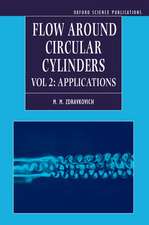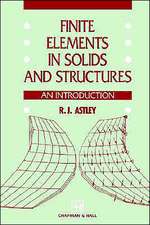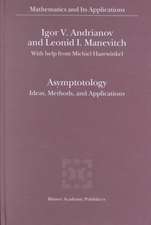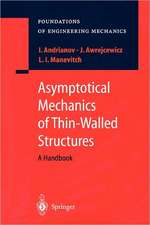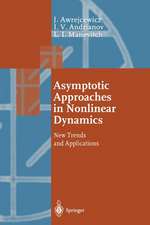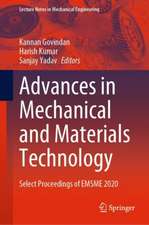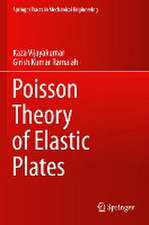Tractable Models of Solid Mechanics: Formulation, Analysis and Interpretation: Foundations of Engineering Mechanics
Autor Oleg V. Gendelman, Leonid I. Manevitchen Limba Engleză Paperback – 27 feb 2013
| Toate formatele și edițiile | Preț | Express |
|---|---|---|
| Paperback (1) | 945.47 lei 43-57 zile | |
| Springer Berlin, Heidelberg – 27 feb 2013 | 945.47 lei 43-57 zile | |
| Hardback (1) | 951.59 lei 43-57 zile | |
| Springer Berlin, Heidelberg – 7 ian 2011 | 951.59 lei 43-57 zile |
Din seria Foundations of Engineering Mechanics
- 15%
 Preț: 585.26 lei
Preț: 585.26 lei - 18%
 Preț: 1112.30 lei
Preț: 1112.30 lei - 18%
 Preț: 786.36 lei
Preț: 786.36 lei - 15%
 Preț: 650.55 lei
Preț: 650.55 lei - 15%
 Preț: 646.11 lei
Preț: 646.11 lei - 18%
 Preț: 948.47 lei
Preț: 948.47 lei - 18%
 Preț: 956.69 lei
Preț: 956.69 lei - 15%
 Preț: 643.34 lei
Preț: 643.34 lei - 18%
 Preț: 948.47 lei
Preț: 948.47 lei - 18%
 Preț: 953.82 lei
Preț: 953.82 lei - 18%
 Preț: 951.29 lei
Preț: 951.29 lei - 18%
 Preț: 1386.62 lei
Preț: 1386.62 lei - 15%
 Preț: 644.49 lei
Preț: 644.49 lei - 18%
 Preț: 2117.76 lei
Preț: 2117.76 lei - 18%
 Preț: 951.91 lei
Preț: 951.91 lei - 18%
 Preț: 957.62 lei
Preț: 957.62 lei -
 Preț: 391.99 lei
Preț: 391.99 lei - 18%
 Preț: 1223.43 lei
Preț: 1223.43 lei - 18%
 Preț: 1213.46 lei
Preț: 1213.46 lei - 15%
 Preț: 634.32 lei
Preț: 634.32 lei - 15%
 Preț: 644.30 lei
Preț: 644.30 lei - 18%
 Preț: 952.26 lei
Preț: 952.26 lei - 15%
 Preț: 646.11 lei
Preț: 646.11 lei - 15%
 Preț: 641.71 lei
Preț: 641.71 lei - 15%
 Preț: 635.01 lei
Preț: 635.01 lei - 18%
 Preț: 955.25 lei
Preț: 955.25 lei - 18%
 Preț: 1234.46 lei
Preț: 1234.46 lei - 20%
 Preț: 1289.59 lei
Preț: 1289.59 lei - 18%
 Preț: 952.89 lei
Preț: 952.89 lei - 18%
 Preț: 1247.88 lei
Preț: 1247.88 lei - 18%
 Preț: 947.18 lei
Preț: 947.18 lei - 15%
 Preț: 631.21 lei
Preț: 631.21 lei - 18%
 Preț: 1231.16 lei
Preț: 1231.16 lei
Preț: 945.47 lei
Preț vechi: 1153.02 lei
-18% Recomandat Nou
Puncte Express: 1418
Preț estimativ în valută:
180.97€ • 196.64$ • 152.12£
180.97€ • 196.64$ • 152.12£
Carte tipărită la comandă
Livrare economică 21 aprilie-05 mai
Preluare comenzi: 021 569.72.76
Specificații
ISBN-13: 9783642266621
ISBN-10: 3642266622
Pagini: 316
Ilustrații: XIV, 302 p.
Dimensiuni: 155 x 235 x 17 mm
Greutate: 0.45 kg
Ediția:2011
Editura: Springer Berlin, Heidelberg
Colecția Springer
Seria Foundations of Engineering Mechanics
Locul publicării:Berlin, Heidelberg, Germany
ISBN-10: 3642266622
Pagini: 316
Ilustrații: XIV, 302 p.
Dimensiuni: 155 x 235 x 17 mm
Greutate: 0.45 kg
Ediția:2011
Editura: Springer Berlin, Heidelberg
Colecția Springer
Seria Foundations of Engineering Mechanics
Locul publicării:Berlin, Heidelberg, Germany
Public țintă
ResearchRecenzii
From the reviews:
“This book by L. I. Manevitch and O. V. Gendelman is focused on a series of so-called ‘tractable models’. … This book presents new original ideas in analysis of models from very different topics of nonlinear mechanics. The proposed approaches allow the authors to simplify complicated nonlinear problems and describe some important solutions. This book may be useful for specialists dealing with nonlinear mechanics, for theoretical physicists, and also for use in academic courses. The book is recommended for libraries.” (Yuri V. Mikhlin, Mathematical Reviews, Issue 2012 a)
“This book by L. I. Manevitch and O. V. Gendelman is focused on a series of so-called ‘tractable models’. … This book presents new original ideas in analysis of models from very different topics of nonlinear mechanics. The proposed approaches allow the authors to simplify complicated nonlinear problems and describe some important solutions. This book may be useful for specialists dealing with nonlinear mechanics, for theoretical physicists, and also for use in academic courses. The book is recommended for libraries.” (Yuri V. Mikhlin, Mathematical Reviews, Issue 2012 a)
Textul de pe ultima copertă
This book describes significant tractable models used in solid mechanics - classical models used in modern mechanics as well as new ones. The models are selected to illustrate the main ideas which allow scientists to describe complicated effects in a simple manner and to clarify basic notations of solid mechanics. A model is considered to be tractable if it is based on clear physical assumptions which allow the selection of significant effects and relatively simple mathematical formulations.
The first part of the book briefly reviews classical tractable models for a simple description of complex effects developed from the 18th to the 20th century and widely used in modern mechanics. The second part describes systematically the new tractable models used today for the treatment of increasingly complex mechanical objects – from systems with two degrees of freedom to three-dimensional continuous objects.
The first part of the book briefly reviews classical tractable models for a simple description of complex effects developed from the 18th to the 20th century and widely used in modern mechanics. The second part describes systematically the new tractable models used today for the treatment of increasingly complex mechanical objects – from systems with two degrees of freedom to three-dimensional continuous objects.
Caracteristici
Presents the new idea of "tractable models" – an approach for a systematic description of Solid Mechanics The idea of tractable models is illustrated by reviewing classical models as tractable models and worked out systematically worked out for models used in modern Solid mechanics Written for experts in this field Includes supplementary material: sn.pub/extras

